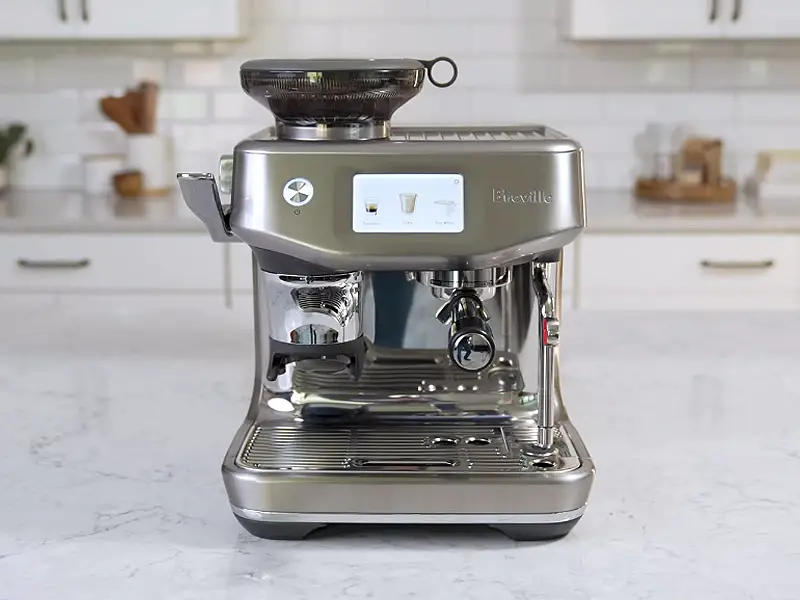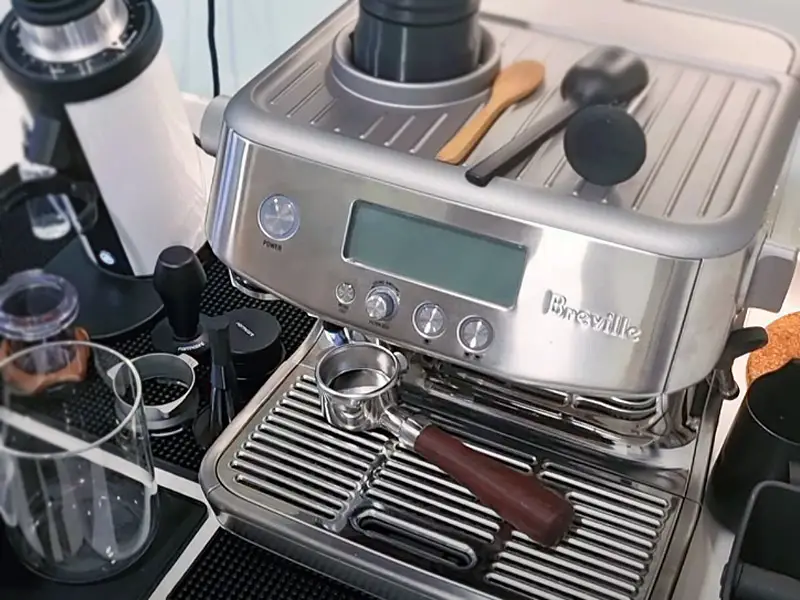As an Amazon Associate, I earn from qualifying purchases at no extra cost to you.
Why Does My Breville Have No Pressure? Troubleshooting Tips
You are not the only one who has ever wondered why your Breville espresso machine doesn’t seem to have the pressure it needs to make a great brew. A lot of people who like espresso worry about the problem of low pressure. This detailed guide will look into the different reasons why Breville machines have low pressure. It will also include fixing tips and possible solutions to help you make a rich and flavorful cup of coffee.
The Significance of Pressure in Espresso Brewing
Before we get into the details of Breville espresso machines’ low pressure, let’s take a look at how important pressure is to the process of making espresso. Pressure is one of the most important things that helps get the taste out of coffee grounds. High-pressure water is pushed through coffee grounds in an espresso machine. This extracts the oils and flavors that give espresso its unique taste and smell.

Common Signs of Low Pressure
Knowing the typical signs of low pressure during the brewing process on your Breville espresso machine is important for using it. If you notice these signs right away, you can diagnose and fix any problems quickly. Take a look at these simple warning signs:
1. Slow Brewing
If your espresso takes noticeably longer to brew than usual, it could be a clear signal of low pressure. Proper pressure is crucial for a timely and efficient extraction process, and a delay in brewing time may suggest a problem with your machine’s pressure levels.
2. Weak Crema
Crema, the golden layer that crowns a well-brewed espresso, should be rich and full-bodied. In cases of low pressure, the crema can appear thin and weak. Monitoring the thickness and quality of the crema can provide insights into the effectiveness of the extraction process.
3. Lackluster Flavor
Espresso is celebrated for its bold and intense flavor profile. If you notice that your coffee lacks the usual robustness or depth of flavor, it could be an indication of low pressure affecting the extraction process. Consistent pressure is key to unlocking the full range of flavors from your coffee grounds.
4. Inconsistent Shots
Low pressure often leads to variations in the quality of espresso shots. Some shots may turn out too weak, while others might be too strong. If you experience inconsistency in the flavor and strength of your shots, it’s worth investigating the pressure settings of your machine.
5. Unusual Sounds
Pay attention to the sounds your espresso machine makes during the brewing process. Unusual noises, such as sputtering or hissing, may suggest that the water isn’t flowing through the machine as it should. These sounds can be audible indicators of potential low-pressure issues.
6. Reduced Crema Thickness
Check the thickness and longevity of the crema on your espresso. If it appears thinner than usual or dissipates rapidly, it could be a sign of insufficient pressure. The crema contributes significantly to the overall sensory experience of your coffee, and changes in its characteristics may point to underlying pressure-related issues.
Being attentive to these common signs allows you to take proactive measures in maintaining and troubleshooting your Breville espresso machine, ensuring a consistent and satisfying coffee experience.
Potential Causes of Low Pressure
1. Coffee Grind Size
One of the primary factors that can affect the pressure in your Breville machine is the grind size of your coffee beans. If the grind is too fine, it can create a blockage in the machine, reducing water flow and, consequently, lowering the pressure. Conversely, a too coarse grind may lead to water passing through too quickly, also resulting in insufficient pressure.
To address this, experiment with different grind sizes to find the optimal setting for your machine. Refer to your Breville user manual for guidelines on the recommended grind size.
2. Coffee Tamping Technique
Tamping is a crucial step in the espresso-making process. If the coffee grounds are not tamped down with the right amount of pressure, it can impact the flow of water through the coffee puck. Inadequate tamping can lead to water channeling, causing low pressure during extraction.
Ensure that you are tamping the coffee evenly and with the correct pressure. Investing in a good quality tamper and practicing the proper technique can make a significant difference in achieving the right pressure for your espresso.
3. Water Temperature
The temperature of the water used in brewing espresso is another factor that can influence pressure. If the water is too hot, it can lead to over-extraction and bitter-tasting coffee. On the other hand, water that is too cold may not extract enough flavors, resulting in weak and underwhelming espresso.
Check the temperature settings on your Breville machine and ensure they align with the recommended brewing temperature for espresso, usually around 195 to 205 degrees Fahrenheit (90 to 96 degrees Celsius).
4. Blocked or Dirty Portafilter Holes
Over time, coffee oils and particles can accumulate in the portafilter holes, leading to blockages that impede water flow. Regular cleaning and maintenance of your portafilter are essential to prevent this issue. Remove the basket and clean the portafilter thoroughly after each use. Additionally, run water through the portafilter to clear any residual coffee grounds.
5. Scale Buildup in the Machine
Scale buildup, caused by mineral deposits in the water, is a common issue in espresso machines. If not addressed, scale can clog the internal components of the machine, including the pump and tubes, resulting in decreased pressure.
Regularly descale your Breville espresso machine following the manufacturer’s recommendations. Using a descaling solution helps remove mineral deposits and ensures the proper functioning of the machine.
6. Malfunctioning Pump
In some cases, low pressure may be attributed to a malfunctioning pump. The pump is responsible for generating the pressure needed to push water through the coffee grounds. If the pump is faulty or worn out, it can lead to insufficient pressure during extraction.
If you’ve ruled out other potential causes, consider contacting Breville customer support or a qualified technician to assess and potentially replace the pump.

Troubleshooting Low-Pressure Issues
Now that we’ve identified potential causes of low pressure in Breville espresso machines, let’s explore some troubleshooting tips to help you address the issue effectively.
1. Adjusting Grind Size and Dose
Experiment with different grind sizes and coffee doses to find the right combination for your machine. Make small adjustments and observe how they affect the extraction process. Keep in mind that the ideal grind size and dose can vary based on the type of coffee beans you’re using.
2. Ensuring Proper Tamping Technique
Pay close attention to your tamping technique. Use a consistent amount of pressure and ensure that the coffee grounds are evenly distributed in the portafilter. Consider investing in a calibrated tamper to achieve more consistent results.
3. Monitoring Water Temperature
Regularly check and calibrate the water temperature on your Breville machine. If you suspect temperature issues, use a separate thermometer to verify the accuracy of the machine’s readings. Adjust the temperature settings as needed to achieve optimal brewing conditions.
4. Thorough Cleaning of Portafilter and Machine Components
Establish a regular cleaning routine for your espresso machine. Disassemble the portafilter and clean all components thoroughly. Remove and clean the shower screen, group head, and any other removable parts. Run water through the machine without coffee grounds to flush out any remaining residues.
5. Descaling the Machine
Follow the manufacturer’s guidelines for descaling your Breville espresso machine. Use a descaling solution that is compatible with your machine to remove scale buildup and ensure proper water flow. Regular descaling not only prevents low pressure but also extends the lifespan of your machine.
6. Professional Assessment for Pump Issues
If all else fails, and you suspect a pump malfunction, it’s advisable to seek professional assistance. Contact Breville customer support or consult a certified technician to inspect and potentially replace the pump if necessary.
Final Words
Overall, you need to be methodical to figure out what’s wrong with your Breville espresso machine and fix it. Looking at things like grind size, tamping method, water temperature, cleaning, and possible pump problems can help you figure out what’s wrong and fix it.
Remember that being patient and trying different things is needed to get the perfect espresso. Don’t be afraid to try combining variables in different ways to find the best settings for your computer and taste. With regular upkeep and care, you can get years of consistently good espresso from your Breville machine.
